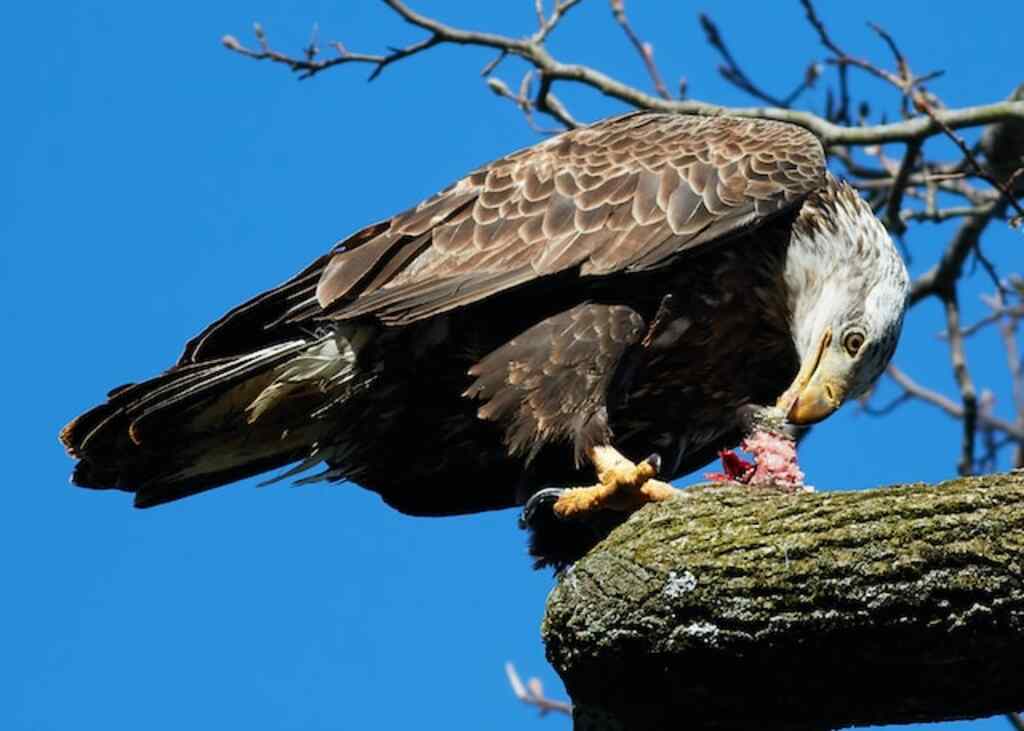Do Eagles Eat Worms? While it may seem unlikely, this question has intrigued many. Join us on a captivating journey into the world of eagle diets.
We’ll challenge misconceptions, explore their hunting techniques, preferred food sources, and unique behaviors.
Delve into scientific research and gain a deeper understanding of these remarkable creatures. Let’s satisfy your curiosity and contribute to eagle conservation and appreciation.
Table of Contents
- 1 Key Takeaways
- 2 Eagles’ Hunting Techniques
- 3 Preferred Food Sources
- 4 Surprising Facts about Eagles’ Diets
- 5 Adaptations for Hunting and Feeding
- 6 Do Eagles Eat Worms
- 7 Misconceptions about Eagles’ Diets
- 8 Unique Dietary Behaviors of Specific Eagle Species
- 9 Role of Diet in Eagle Conservation
- 10 Interactions with Other Predators
- 11 Eagle Feeding and Parenting Behaviors
- 12 Frequently Asked Questions
- 12.1 How do eagles catch their prey?
- 12.2 What are some of the preferred food sources for eagles?
- 12.3 Are there any surprising facts about eagles’ diets that most people don’t know?
- 12.4 What adaptations do eagles have specifically for hunting and feeding?
- 12.5 What are some common misconceptions about eagles’ diets that people may have?
- 13 Conclusion
- 14 Author
Key Takeaways
- Eagles have a diverse diet that includes small mammals, birds, fish, and carrion.
- Eagles occasionally eat invertebrates such as worms, making up to 5% of their diet.
- Eagles play a vital role in the ecosystem by reducing the spread of disease through carrion consumption.
- Dietary variations exist among eagle species, influenced by different habitats.

Eagles’ Hunting Techniques
Eagles employ a variety of hunting techniques, relying on their keen eyesight, impressive aerial agility, and remarkable speed to capture their prey efficiently.
These majestic birds are known for their remarkable hunting strategies, which vary depending on the species and the environment they inhabit.
Some eagles, such as the Bald Eagle, prefer to perch on high vantage points, scanning the surroundings for potential prey.
Once a target is spotted, they swiftly dive with precision and incredible speed, using their powerful talons to snatch their prey from the water’s surface.
Other species, like the Golden Eagle, utilize a different tactic known as ‘stooping,’ where they soar at great heights before making a sudden, steep dive towards their target.
This strategy allows them to take advantage of their incredible speed and momentum to capture their prey.
The eagle’s prey selection is based on a combination of factors, including the availability of food sources and their own dietary needs.
Transitioning into the subsequent section about ‘preferred food sources,’ eagles’ hunting techniques are closely linked to their preferred food sources.
Preferred Food Sources
The preferred food sources of eagles include fish as a primary diet, birds, small mammals, and reptiles.
Eagles are known for their exceptional fishing skills and rely heavily on fish as a primary source of nutrition.
In addition, they also prey on various birds, small mammals, and reptiles, displaying their adaptability and diverse diet.
Furthermore, eagles are opportunistic feeders and often scavenge on carrion, further expanding their food sources and ensuring their survival in different environments.
Fish as a Primary Diet
Fish are often considered a primary diet for certain bird species due to their high nutritional value and availability in aquatic environments.
For instance, a study conducted on ospreys in the Chesapeake Bay revealed that fish accounted for 99% of their diet, highlighting the significance of fish as a primary food source for these birds.
Fish conservation is crucial for maintaining the population of these bird species, as they heavily rely on fish for their survival.
However, the impact of pollution on fish populations can have detrimental effects on these bird species, as pollutants can accumulate in fish and subsequently be transferred to the birds that consume them.
Therefore, efforts to reduce pollution and promote fish conservation are essential for ensuring the continued availability of this primary food source for birds.
Transitioning into the subsequent section about birds, small mammals, and reptiles, the diet of these birds encompasses a broader range of prey items beyond fish.
Birds, Small Mammals, and Reptiles
Birds, small mammals, and reptiles have a diverse diet that includes a variety of prey items beyond their primary food source.
Birds of prey, such as eagles, employ different hunting techniques to capture their preferred food sources.
For example, some birds, like the American kestrel, rely on their sharp vision and nimble flight to catch insects and small birds.
Others, such as the red-tailed hawk, use their powerful talons to capture small mammals like mice and rabbits.
Reptiles, like snakes, often consume small birds and mammals, as well as frogs and lizards.
These hunting techniques and preferred food sources allow birds and reptiles to adapt to their environments and ensure their survival.
Moving forward, the discussion will focus on the carrion and scavenging habits of these creatures.
Carrion and Scavenging
Carrion and scavenging play a crucial role in the ecological dynamics of various animal species, as they provide an alternative source of nutrition that supports their survival and sustains the balance of the ecosystem.
Carrion, which refers to the decaying flesh of dead animals, serves as an important food source for many scavengers, including eagles.
When an animal dies, the process of carrion decomposition begins, involving the breakdown of organic matter by bacteria, fungi, and other decomposers.
This decomposition process not only recycles nutrients back into the ecosystem, but also helps to prevent the spread of diseases by removing carcasses.
Eagles, as opportunistic scavengers, rely on carrion as a significant part of their diet, particularly when their primary prey is scarce.
Understanding the ecological impact of carrion and the scavenging behavior of eagles provides valuable insights into the intricate dynamics of the food web.
Transitioning into the subsequent section about ‘surprising facts about eagles’ diets’, it is interesting to explore the diverse range of food sources that eagles consume.

Surprising Facts about Eagles’ Diets
Intriguingly, eagles have been known to consume a wide range of prey items, expanding their diet beyond the conventional expectations.
This variation in eagle diet is not only fascinating, but also has important implications for the ecosystems they inhabit.
Here are four surprising facts about eagles’ diets:
- Fish: Eagles are well-known for their ability to catch fish. They have sharp talons and keen eyesight, which enable them to snatch fish from the water’s surface.
- Small mammals: Eagles also prey on small mammals such as rabbits, squirrels, and rodents. They use their powerful beaks to tear through the fur and flesh of their prey.
- Birds: Eagles are opportunistic hunters and will not hesitate to prey on other birds. They have been observed attacking smaller birds in mid-flight and have even been known to snatch young waterfowl from the water.
- Carrion: While eagles are skilled hunters, they also scavenge for carrion. They play an important role in cleaning up carcasses, preventing the spread of disease within their ecosystem.
These dietary variations have a significant impact on the ecosystem, as eagles help regulate populations of their prey and contribute to the overall balance of the food chain.
Transitioning to the next section on adaptations for hunting and feeding, it is clear that eagles have evolved specialized characteristics that enable them to effectively capture their diverse prey.
Adaptations for Hunting and Feeding
When it comes to hunting and feeding, eagles possess several adaptations that enable them to excel in these activities.
One of their key adaptations is their sharp eyesight and acute hearing, which allows them to spot their prey from great distances and accurately locate it even in challenging environments.
Additionally, eagles have a specialized digestive system and metabolism that enables them to efficiently extract nutrients from their food sources, which often include large prey items.
Finally, their talon and beak strength provide them with the necessary tools to capture and kill their prey, allowing them to secure their food source with ease.
Sharp Eyesight and Acute Hearing
Eagles possess an extraordinary ability to spot prey from great distances due to their sharp eyesight and acute hearing.
Their eyes are specially adapted to detect movement and spot small prey from high altitudes.
With their large eyes and high number of photoreceptor cells, eagles have a visual acuity that is far superior to that of humans.
Additionally, their eyes have a higher density of color-sensitive cone cells, allowing them to perceive a wider range of colors.
Furthermore, eagles have excellent depth perception, enabling them to accurately judge the distance of their prey.
In addition to their keen eyesight, eagles also rely on their acute hearing to locate prey. They have highly developed auditory systems that can detect high-frequency sounds and even the faintest rustling of prey.
This combination of sharp eyesight and acute hearing gives eagles a distinct advantage when it comes to hunting. Moving on to their digestive system and metabolism…
Digestive System and Metabolism
The efficiency of the eagle’s digestive system and metabolism allows for optimal energy extraction from their prey.
Eagles have a highly specialized digestive system that enables them to break down and absorb nutrients from their food effectively.
Their beak and talons are used to tear apart the prey, exposing it to the digestive juices in their stomach.
The strong acids in the stomach break down proteins, while the muscular stomach walls churn the food, aiding in the digestion process.
The partially digested prey then moves into the eagle’s intestines, where nutrient absorption takes place.
The intestines are lined with tiny finger-like projections called villi, which increase the surface area available for nutrient absorption.
This efficient digestion and nutrient absorption enable eagles to obtain maximum energy from their food.
Transitioning to the subsequent section about talon and beak strength, eagles also possess impressive physical adaptations that aid in capturing and handling their prey.
Talon and Beak Strength
Impressive physical adaptations, such as their powerful talons and beaks, allow eagles to efficiently capture and handle their prey.
The talons of eagles are sharp and curved, enabling them to grasp and immobilize their prey with great precision.
The beaks of eagles are strong and sharp, which helps them tear apart their prey and extract the meat. These anatomical features are essential for their hunting strategies and techniques.
Eagles primarily use their talons to catch their prey, swooping down from the sky or diving into the water to snatch fish.
They also use their beaks to tear off small pieces of meat from larger prey or to feed on smaller prey. This combination of talon and beak strength makes eagles formidable hunters in their natural habitats.
| Talon and Beak Anatomy | Hunting Strategies and Techniques |
|---|---|
| Sharp and curved talons | Swooping down from the sky |
| Strong and sharp beaks | Diving into the water |
| Grasping and immobilizing prey | Tearing off small pieces of meat |
| Extracting the meat from prey | Feeding on smaller prey |
Eagles’ talon and beak anatomy, coupled with their hunting strategies and techniques, make them highly successful predators. However, there are still some misconceptions about eagles’ diets that need to be addressed.

Do Eagles Eat Worms
No, eagles do not typically eat worms. Their diet mainly consists of meat, such as fish, small mammals, birds, and reptiles. While they may consume small invertebrates on occasion, worms are not a significant part of an eagle’s diet.
Misconceptions about Eagles’ Diets
Contrary to popular belief, the diet of eagles does not consist solely of worms.
For instance, a study conducted in the Pacific Northwest found that bald eagles primarily feed on fish, with salmon being a significant component of their diet during the spawning season.
This finding dispels common myths about eagles’ nutritional requirements, which are often misunderstood due to misconceptions.
To provide a deeper understanding, here are three subtopics to consider:
- Variety of Prey: Eagles have a diverse diet that includes mammals, birds, reptiles, and even carrion. They are opportunistic hunters, adapting their feeding habits to available resources.
- Hunting Techniques: Eagles employ various hunting techniques, such as aerial pursuit, stooping, or perch hunting, depending on their prey. They exhibit exceptional aerial agility and use their sharp vision to spot potential targets from great distances.
- Interactions with Other Species: Eagles have complex interactions with other species. For example, they may steal food from other birds, scavenge from human settlements, or engage in kleptoparasitism, where they steal prey from other eagles or predators.
Understanding the unique dietary behaviors of specific eagle species provides insight into their ecological role and helps conserve these magnificent birds without restricting their freedom.
Unique Dietary Behaviors of Specific Eagle Species
Misconceptions about the diets of eagles are common, and understanding the unique dietary behaviors of specific eagle species can help dispel these misconceptions.
Different eagle species exhibit distinct feeding patterns and dietary variations, which contribute to their survival and ecological role.
To delve deeper into this topic, let’s explore a table that highlights the dietary preferences of five prominent eagle species:
| Eagle Species | Primary Prey | Secondary Prey | Tertiary Prey | Supplementary Prey |
|---|---|---|---|---|
| Bald Eagle | Fish | Birds | Small Mammals | Carrion |
| Golden Eagle | Small Mammals | Birds | Reptiles | Insects |
| African Fish Eagle | Fish | Birds | Reptiles | Aquatic Invertebrates |
| Harpy Eagle | Arboreal Mammals | Birds | Reptiles | Primates |
| Steller’s Sea Eagle | Fish | Birds | Aquatic Mammals | Crustaceans |
Understanding these diverse feeding patterns and dietary variations is crucial for eagle conservation efforts.
By studying the role of diet in eagle conservation, we can gain insights into their habitat requirements, identify key threats, and develop effective conservation strategies.
Transitioning into the subsequent section, we will explore the significance of diet in the conservation of eagle populations.
Role of Diet in Eagle Conservation
The study of eagle diets plays a vital role in the conservation of these majestic birds, as it provides valuable insights into their ecological requirements and aids in the development of effective conservation strategies.
Understanding their dietary preferences allows researchers to assess the impact of human activities on their food sources and make informed decisions to mitigate potential threats.
Here are four key points regarding the role of diet in eagle conservation:
- Dietary preferences: Examining the specific prey species consumed by eagles helps identify their preferred food sources and understand their nutritional needs.
- Impact on ecosystem: Eagles are top predators in their habitats, and changes in their diet can have cascading effects on the entire ecosystem. Studying their feeding habits can help assess the overall health and balance of the ecosystem.
- Conservation planning: By understanding the dietary requirements of different eagle species, conservationists can develop targeted management plans to ensure the availability of suitable prey and protect critical habitats.
- Monitoring population health: Tracking changes in eagle diets over time can provide valuable information on the health and abundance of their prey species, allowing for early detection of potential declines and the implementation of appropriate conservation measures.
These insights into eagle diets and their ecological significance lay the foundation for understanding their interactions with other predators in the subsequent section.

Interactions with Other Predators
Interactions between eagles and other predators in their habitat are essential to understanding the dynamics of the ecosystem and the role each species plays in maintaining its balance.
Eagles are apex predators and have a significant impact on local ecosystems through their interactions with other predators. They often compete with other raptors, such as hawks and owls, for prey resources.
This competition can lead to changes in prey availability and distribution, which can then have cascading effects on the entire food web.
Additionally, eagles may also interact with terrestrial predators, such as wolves or coyotes, as they scavenge on carcasses left by these predators.
These interactions can influence the spatial distribution of both eagles and other predators, as well as shape their feeding behaviors.
Understanding these interactions is crucial for effective conservation and management strategies.
Transitioning into the subsequent section about eagle feeding and parenting behaviors, it is important to consider how these interactions with other predators may influence their overall reproductive success and population dynamics.
Eagle Feeding and Parenting Behaviors
Eagle feeding and parenting behaviors are crucial aspects of their reproductive success and population dynamics.
Eagles are primarily carnivorous, and their feeding habits vary depending on the species and the availability of prey.
They are opportunistic hunters and feed on a variety of prey, including fish, small mammals, reptiles, and birds.
Their hunting strategies involve soaring high in the sky and using their keen eyesight to spot potential prey from a distance.
Once they have located a target, eagles use their powerful talons to capture and kill the prey.
In terms of parenting strategies, eagles are known for their strong parental instincts. They typically mate for life, and both parents play an active role in raising their young.
The female eagle lays eggs and both parents take turns incubating them. Once the eggs hatch, the parents take turns hunting and feeding the chicks.
The young eagles remain in the nest for several months, during which time they are fed by their parents until they are old enough to venture out and hunt on their own.
These feeding and parenting behaviors are essential for the survival and growth of eagle populations.
Frequently Asked Questions
How do eagles catch their prey?
Eagles employ various hunting techniques to catch their prey, such as aerial attacks, perch hunting, and stealthy approaches. Their preferences for prey vary depending on the species, but they commonly target small mammals, birds, and fish.
What are some of the preferred food sources for eagles?
Eagles exhibit a diverse diet, choosing prey based on availability and their own hunting prowess. They display preferences for fish, small mammals, birds, and carrion, showcasing their adaptability and efficient feeding habits.
Are there any surprising facts about eagles’ diets that most people don’t know?
Surprising dietary habits of eagles include their ability to adapt and consume a variety of prey, such as fish, small mammals, birds, and reptiles. Unique feeding behaviors of eagles involve hunting techniques, such as aerial dives and scavenging.
What adaptations do eagles have specifically for hunting and feeding?
Eagles, masters of the sky, possess remarkable adaptations for hunting and feeding. Their sharp talons, like razor-sharp daggers, grasp prey with precision. Their curved beak, a fierce hook, tears flesh effortlessly. Such adaptations ensure their successful pursuit and consumption of prey.
What are some common misconceptions about eagles’ diets that people may have?
Common myths about eagles’ food sources include the misconception that they primarily eat worms. However, eagles are carnivorous birds that typically feed on fish, small mammals, and birds, using their sharp beaks and talons to catch and kill their prey.

Conclusion
In conclusion, the diet of eagles is varied and adaptable, allowing them to thrive in various habitats around the world.
Their hunting techniques and preferred food sources demonstrate their impressive abilities as apex predators.
Despite some misconceptions, eagles’ diets are not limited to worms, as they often consume a wide range of prey including fish, mammals, and birds.
Understanding the unique dietary behaviors of different eagle species is crucial for their conservation.
The role of diet in eagle parenting and interactions with other predators further highlights their significance in ecosystems.
Overall, eagles’ dietary habits are awe-inspiring, showcasing their remarkable adaptations and making them truly majestic creatures of the skies.



